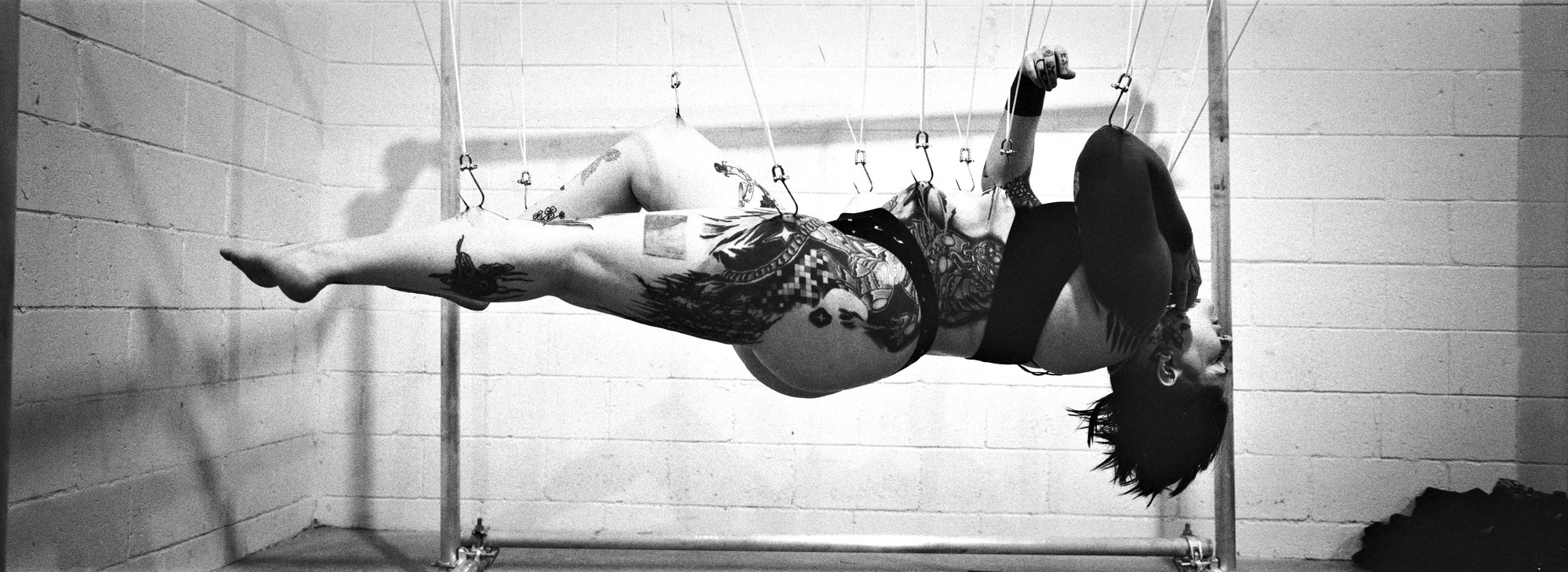 |
| Photo Credit: Jerome Abramovitch / chapter9photography.com |
Three years ago, John Berg, now the president of marketing firm Taxi NYC, sent out the following message to the employees of another marketing firm, Bulldog New York:
It is with profound sadness that we inform you that Keith Alexander, Bulldog New York’s head of technology, lost his life in a bike accident last evening. Bicycling was one of Keith’s newest passions. Those who knew Keith well saw the intensity and the enthusiasm he threw at new things that excited him. As with most of his passions, Keith was way into bicycling and its technology, history, mysticism and how it’s done at the very highest level. He had become a huge Lance Armstrong fan. These past weeks I would receive several links daily about Lance’s prospects in the Tour de France. There is no question that Keith died as he lived, doing something he absolutely loved.
Keith was with us from the very beginning, committing himself to our success and was a steadfast presence helping us through the bumpy early days. We all loved Keith for his fiery determination, perfectionist qualities and huge heart. Bulldog New York will not be the same without him. We will miss him always.
On this, the third anniversary of his death, I’ve invited some of Keith’s friends and loved ones to share memories, stories, and to comment on their lives over the past three years.
* * *
It is very hard for me to believe that it has been three years already.
I’m not going to do the usual thing that people do on the anniversary of someone’s death and sit here telling stories about the person while they were still with us — there are plenty of other motherfuckers out there who will be better qualified to handle that angle for you.
Instead, I’m going to tell you all a little secret, so hold tight and check this out:
I don’t think a day goes by where I do not ask myself, “WWKAD?”
That’s right, I said it. “What would KA do?” It happens to me almost instantaneously, in any and every situation. Not long after KA was killed, my father was diagnosed with terminal cancer. Immediately, my mind raced to “WWKAD?” and I received the answer with the quickness: Drop it all and do the right thing by my father. And that is exactly what I did, no matter how hard or fucked up it was.
When I got back to NYC after my father’s death, I needed a job and fast. So, my mind pulled out “WWKAD?” and I did what he taught me (and countless others) to do: I sort of conned my way into a job I wasn’t all-the-way qualified for. Once ensconced in that job, I took the rest of the advice and gave myself 90 days to learn how to do that job better than anyone else had ever done before me.
And now?
Now I run that company’s entire East Coast operations, and I do it better than anyone else ever has.
This whole “WWKAD?” thing has pushed my monkey-ass to do everything I can to better myself every day. To no longer waste time and sit around feeling fucking sorry for myself when shit doesn’t necessarily go my way. Hell, if it wasn’t for “WWKAD?” I probably wouldn’t have got my act together and met my wife.
It’s as if I have this little audio clip stuck in the tiniest portion of my brain that comes rumbling out of the darkness whenever adversity dares to show itself to me, and that clip is Keith’s voice, telling me to push further, to work harder, to learn more.
I might not have know him as long as some, but the lessons he taught me will keep working that Brooklyn magic for the rest of my life.
And you can bank on that shit.
* * *
Keith Alexander was the kind of person that is difficult to sum up in a paragraph. Hell, anyone would be hard pressed to try and summarize Keith in a Dostoevsky-length novel. I can’t begin to describe who he was, what he meant to me as a friend, or even share an anecdote without feeling that it doesn’t do him justice. The impact he had on the people who knew him was incredibly deep and long-lasting. I’ve heard some people say he was an asshole, but that really wasn’t it — he was just a straight shooter from Brooklyn who didn’t take shit from anybody and wouldn’t let friends or acquaintances just sit back and whine when things didn’t go their way. He enjoyed a good-natured ball-busting. If you were his friend and something went wrong, though, he’d go out of his way and drop everything to make sure you were okay. And then once you were, he’d bust your balls about it.
I have learned lots of things from Keith, both from his life and from his death. From his life, I learned to never take shit from anybody, to look at things that others might see as setbacks as opportunities, and to bullshit my way through things I knew I could learn quickly. (One of Keith’s mantras: Give me 60 days, and I can learn it.) He encouraged me to take leaps of faith with my career, and it’s his encouragement that still drives me to take informed risks, like starting my own companies. From his death, I learned to never take anyone for granted, and not to ever put off things I wanted to do until later. Since he died, my relationships with my friends and family have gotten stronger, and I’ve strived to live every day to the fullest, just like he did.
* * *
Dee Snider was researching his movie Strangeland when he met Keith. While visiting Gauntlet NYC and perusing the shop, Keith recognized him almost immediately, introduced himself and, when he found out Snider was making a movie heavily related to piercing, he invited Snider to come watch him pierce a client, then and there. Snider’s first piercing experience? A Prince Albert.
“Thankfully,” Snider says, “Keith positioned himself between [the client and me], so at least I didn’t have to see this dude’s johnson.
“But Keith realized that, and told me to ‘scooch over’ so I could see the whole process.”
Though it was a bizarre occurrence, Snider says Keith’s bedside manner was stunning, so much so that he brought his six-month-old daughter, Cheyenne, to get her ears pierced by Keith. Snider, during the same visit, got his septum pierced, which went smoothly. As for Cheyenne’s piercings, though?
“He was so nervous,” Snider says, laughing, “the placement was all wrong. We ended up having to take them out and had a dermatologist redo them.”
Strangeland centered on a sadistic serial killer named Captain Howdy, played by Snider, who tortured his victims with bizarre body piercing techniques. Keith ended up serving as the film’s “piercing advisor,” a role Snider says Keith knew would draw backlash from the piercing community, and understandably — Snider admits that the character he created was borne from his own misconceptions.
“I thought it was a self-mutilation thing,” Snider says of body modification, “something done in anger, something done to make you less attractive.” But Keith’s guidance changed his view of the community, and made him realize one thing in particular: This movie was going to piss off a lot of people. Knowing this, Snider readjusted his focus and sought to drive home the fact that Captain Howdy was an outsider, that he was not a member of the community, and that he was a bad guy who was tarnishing the reputation of pierced and tattooed people.
Even still, Snider says, Keith knew people would fault him for his participation in the project, but he refused to compromise, refused to abandon the film.
“He wouldn’t be pressured by what the population thought,” Snider says of Keith. “I think that maybe he resisted because of the pressure — that if people didn’t get on his case about it, he wouldn’t have cared so much.”
The Many Faces of Keith Alexander
Once they became acquainted, Snider told Keith he was planning on putting a band together to do some touring and to play some old Twisted Sister songs. Keith, being a fan of Snider’s and a well known musician in his own right (he was a founding member of Carnivore and Primal Scream NYC), seemed like a natural fit, and the resulting band — Dee Snider’s Sick Motherfuckers — ended up being built around Keith. On their first tour, when the tour bus hit Brooklyn to pick up Keith, he was dressed entirely in bright yellow. Says Snider,
“This was the ‘yellow tour.’ We showed up, and he was wearing this yellow rain slicker, yellow hat, yellow everything. He looked like a yellow version of the Michelin Man. And he was as into technology as he was into yellow, apparently, so he had matching yellow walkie-talkies for us all, yellow CD players, everything. It was weird, but we went with it, because that was Keith.”
When they came to pick up Keith for the next tour, he had “dropped 50 pounds, cut off all his hair and got a military cut. He looked like a fucking marine! But he was so passionate about these things, nobody would ever question it.”
On the last tour Keith did with the band, he decided on another gimmick — one ostensibly more practical than the last.
“That was the ‘poncho tour,’” Snider says, laughing. “Keith had somehow decided that the poncho was the single greatest accessory a man could wear. It was the most utilitarian item possible. It was warmth, it was comfort, it was a port in a storm, it was everything.
“So we showed up in Brooklyn to pick him up for the tour, and there he was, wearing shorts, sandals, a cowboy hat and a poncho. He looked absolutely ridiculous.”
* * *
If you ever went into a body modification-related online chat room prior to July 2005, you would have undoubtedly witnessed what seemed like an attack on someone with a question. The attacker would have been Keith. The secret to all of that vitriol? He was trying to make you think for yourself. He wasn’t just trying to be rude or mean — he was trying to help you learn. People thought he was just being vicious, but the truth of the matter is that he was the ultimate mentor.
Keith was — and, in some sense, still is — my greatest teacher.
The last three years have been hard. Not a single day goes by that I don’t think about him. I have had many accomplishments and joy since he has been gone. I changed my career, I had a beautiful baby boy whom we named Alexander, and I continue to have a happy marriage with my amazing husband. I have wonderful friends that I hold close and love.
All of those things? Keith has been there every step of the way. Whispering in my ear: “You can do it,” Look it up and learn it, you will be teaching them in six months,” “Don’t let anyone else tell you what you can and cannot do,” “Live happy and surround yourself with great things.” All of his years of encouragement and teaching, and being my cheerleader (OK — that’s an amusing visual) are still with me.
You see, Keith’s physical presence may be gone, and trust me, it is a huge, huge void in my life, but he is still with me every day. Cheering me on, encouraging me to learn and grow and challenge.
I hope I can teach my son to be the kind of man Keith was. I hope I can teach him the things that Keith taught me. If I can do that — and I will do that; Keith would accept no less — then I can pass on the strength and the confidence that will allow him to become the great man I know he will be.
I still miss Keith so much every day.
* * *
Weeks back, I committed to the task of transferring an aging VHS tape to a more secure digital file. I knew it wouldn’t be the easiest thing in the world to do, but the thought of anything happening to this footage was worth the emotional ramifications. As I slid back in my chair and pushed play, my screen filled with the image of a grinning Keith Alexander. Hair farmer-era Keith. Rock star Keith. Freeze-framed as I fumbled with my questionably obtained editing program, I found myself making eye contact with him.
My first thought wasn’t how much I missed Keith. It was that were he here, he’d be making fun of me for still owning a VCR. He’d likely also be making fun of me for the music I was listening to. And quite possibly my haircut. Or for any number of reasons known only to him. Then he’d tell me he loved me.
As the years pass without Keith around, I don’t know which I miss more: Him breaking my balls (and trust me, my balls were never so expertly broken by anyone else), or him telling me he loved me.
Both have been done, in varying degrees, by scores of others in the three years since he was taken from us, but no one else seems to be able to do them both at the same time with the same effect. No one makes me so succinctly aware of both my wins and my losses in life. No one calls up ex-girlfriends of mine while drunk on Akvavit and tells them he hates them, hanging up as suddenly as he called in a torrent of insane giggling.
I tried to compress my thoughts on Keith into a few tidy paragraphs. Stories culled from memories shared by those of us lucky enough to have known him closely are plentiful. But try as I might, I couldn’t summarize a light so bright in my admittedly limited prose. I can only say that I’m a better man for having known him.
I take comfort in those stories, in the video I transferred, in the remnants of the scar he was kind enough to give me. I take comfort in the fact that he documented every idea that popped in his head via his nootrope.net site and that it’s still online for us to read. Most of all, I take comfort in knowing that through him, people were able to find something in themselves, something primal and beautiful, and share it with the rest of the world.
“Maybe I’ll inspire you to be exactly who you want to be.
Maybe you’ll call me a fool.”
– Keith Alexander
November 23, 1963 – July 11, 2005
For Jordan’s memorial for Keith, click here.































